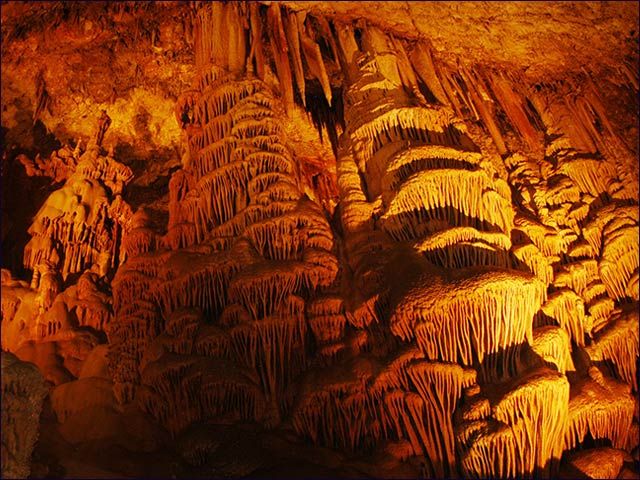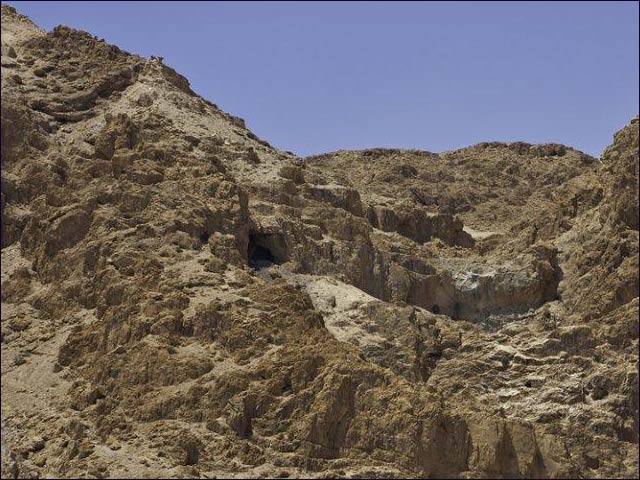By Avigayil Kadesh
Every day of the week, another Israeli cave is discovered. So says Prof. Amos Frumkin, director of the Cave Research Unit at the Hebrew University of Jerusalem’s Geography Department. “Right now we have about 1,200 registered caves in our database, but I can estimate roughly that there are many thousands,” he states.
Frumkin explains that Israel is very rich in soluble rocks. That means rainwater infiltrating underground can dissolve the rock and flow in various directions, creating caves.
“That is the main type of cave we have,” he says. “Another type is artificial caves created by carving out spaces underground for quarries, living quarters, industry, burial, hiding or other reasons. People have also used natural caves for all these purposes.”
Here are some of the most significant caves in Israel:
Sorek (Avshalom) Cave, also called the Stalactite Cave, is in a nature reserve on the western slopes of the Judean mountains between Jerusalem and Beit Shemesh.

Avshalom (Stalactite) Cave
Workers blasting at a limestone quarry 44 years ago came across this small cavern, which contains stalactites and stalagmites ranging from a few inches to 13 feet long. Experts believe some of them are at least 300,000 years old, and in several areas of the cave they are still growing.
“Many caves in the world have stalactites, but this one is special because it was sealed before it was revealed by a quarry, so the formations are very pristine and well-preserved because no humans or animals entered before 1968,” says Frumkin.
The Israel Nature and Parks Authority installed wooden walkways, lighting and handrails inside the cave and offers an audiovisual presentation and guided tour.
Zedekiah’s Cave, just east of Jerusalem’s Damascus Gate, goes back about 1,000 feet under the northern Old City wall, and more than 2,000 years in history. Legend has it that Zedekiah, the last king of the kingdom of Judah in the period of the First Temple, attempted to flee to Jericho through this cave during the Babylonian siege of Jerusalem. He was captured as he came out of the cave, his sons put to death before his eyes, and and he himself was blinded and taken into exile. The spring at the back of the cave is called “Zedekiah’s Tears.”
However, the cave has no exit, and archaeologists believe it was actually the quarry where Herod the Great’s workers cut the giant stones to build the Second Temple. Its English name, King Solomon’s Quarries, is a bit of an anachronism as Solomon’s Temple predated Herod’s by hundreds of years and there is no solid evidence that stone from the cave was used to build the first temple.
The cave is lighted and has signage in Hebrew, Arabic and English. About half of its length is open to the public.
The Mount Sedom Caves at the southwest end of the Dead Sea, a rare formation with more than 100 salt-rock caves, include Malcham, the largest cave in Israel and the largest salt cave in the world. Open free to the public, Malcham (a Hebrew acronym for the Hebrew University’s Cave Research Unit) boasts huge rooms, vertical shafts over 130 meters deep, stalactites and stalagmites made of salt.
“It’s a river cave,” explains Frumkin. “Water flowing in a surface stream flows underground and dissolves the salt, creating caves – a process that is still going on when there is strong rain over the mountain about once a year.”
The 11 Caves of Qumran, overlooking the northwest end of the Dead Sea on the edge of the Judean Desert, are where the Dead Sea Scrolls were discovered in clay jars starting in 1947. The many scrolls include the oldest Bible ever found. You won’t see the writings in the caves anymore – for that, go to the Israel Museum’s Shrine of the Book or
online – but the site has been reconstructed for tourists complete with a video presentation.
You’ll see a room where ancient scribes may have worked and an area where the caves’ ascetic inhabitants dried dates and made clay pots. In the year 68 CE, the invading Romans caused the residents to flee, but first they hid their treasures behind walls of raw stone. The first scroll was discovered by a Bedouin shepherd almost two millennia later, in 1947.

Qumran Cave - (Photo: Alberto Peral/Israel Tourism Ministry)
The Cave of Letters, discovered in 1960 by archaeologist Yigael Yadin in Nahal Hever, contained letters from Shimon Bar Kochba, leader of the Jewish revolt against Rome in the year 132. Yadin found other documents from that period along with human skulls and artifacts. Some historians believe that treasures of the Second Temple may have been hidden here.
In 2000, a second major expedition turned up baskets of bones from 13 individuals, including children. Also discovered were Roman-era textiles, cooking shards, coins, a child’s sandal, a fragment of a mat and a wooden comb.
Pa'ar Cave is a limestone sinkhole in the Upper Galilee formed by water flowing from the surface Pa'ar Stream to the underground.

Pa’ar Cave (Photo: Ron Bar Yaacov/Wikimedia Commons)
“This is maybe the best example of such a limestone phenomenon in Israel,” says Frumkin. “In winter you can follow the water with your eye and see it sinking underground. It’s in a nice [3.5-acre] nature reserve open to the public for free. Just be prepared for mud because it’s an active cave.”
Pa’ar Cave is surrounded by pine and crabapple trees, Kermes oak (Quercus calliprinos), Hawthorn trees and rosebushes.
If you plan to visit the
Hariton Cave, Israel’s largest limestone cave, bring lanterns and wear appropriate shoes – and hire a guide from the nearby field school, because the labyrinth-like cave isn’t easy to navigate. It’s located not far from Bethlehem and
Herodian south of Jerusalem.
Israel’s second-largest limestone cave, the
Ayalon Cave, is unique in the world because its ecosystem lives on chemical energy rather than sunlight. It lies under a layer of chalk that doesn’t let in any water. In 2006, after workers at a major cement quarry near Ramle came across the cave 328 feet beneath the ground, Hebrew University researchers discovered eight ancient, previously unknown animal species inside it.
In the cave’s underground lake – which connects up with one of Israel’s two aquifers -- scientists found aquatic crustaceans and four terrestrial species, all of them thriving on internal bacteria since no photosynthesis is possible and no energy ever enters from outside.
Nicknamed “Noah’s Ark Cave,” it’s unique in the world and isn’t open to the public because scientists are still investigating its vast levels and halls.
HaYonim (The Pigeons) Cave is in a limestone bluff in the upper Galilee. People were living in this cave as many as 250,000 years ago and as “recently” as 12,000 years ago. Excavations have turned up blades, cooking hearths, finished floors and graves.
“This is a good example of a prehistoric natural cave. Such caves could be associated with two types of humans that coexisted in the last Ice Age – Homo sapiens and Neanderthals,” explains Frumkin. “In the Natufian period about 11,000 years ago, people started building small houses, and there are such structures inside the entrance of the cave.”
Visitors can explore part of the cave for free; a gate blocks off the archeological excavation area.
The limestone Kebara Cave in the Carmel Mountains northeast of Caesarea is similar to HaYonim but famous for the 1982 discovery of one of the most complete Neanderthal skeletons ever found. Nicknamed "Moshe," the skeleton is believed to be at least 60,000 years old. Visitors can peek inside the old excavation site for free.
Not far away, a 120,000-year-old Neanderthal-type female skeleton was discovered in the
Tabun (Tanur) Cave, home to humans off and on from 500,000 to 40,000 years ago. The Tabun (“oven”) is part of the
Carmel Caves.

Tabun Cave (Photo: Reuven Yeshurun/Wikimedia Commons)
These caves are in the
Nahal Me’arot Nature Reserve. Apparently a lot of food preparation took place here because many hunting and foraging tools were found along with piles of fallow deer bones and other leftovers of meals long past.
In the Hanahal (or El-Wad) Cave, the largest of the Carmel Caves, an audiovisual presentation explains about prehistoric daily life. There’s also a model of a skeleton illustrating burial customs of the Natufian culture 10,000 years ago. More than 100 ancient people were buried in a tightly flexed position, some with ornaments made of stone, bone or shell.
In June 2012, the World Heritage Committee of UNESCO voted to list the Nahal Me'arot / Wadi el-Mughara Caves as a
UNESCO World Heritage Site.
Qesem Cave, east of Tel Aviv, was discovered 12 years ago by Frumkin. “I was there with a student studying another cave nearby,” he relates. “We were parked on the side of the road and I saw there were many artifacts, such as bones, visible in a section being excavated by bulldozers. Immediately I called the government officials responsible for preserving such sites.”
Qesem’s few human remains date from about 300,000 years ago – significantly, a full 100,000 years older than similar remains found in Africa, suggesting that Homo sapiens migrated much earlier than once thought.
“This was a very special culture common to only a few caves in the Levant,” says Frumkin. “Archeologists found many artifacts and bones from the people who found shelter and lit cooking fires there. In the last few years some human teeth were found, which seem to belong to a species associated closely with us. Qesem might be the oldest site in the world with such remains.”
Beit Guvrin-Maresha National Park is known as the “land of a thousand caves,” the result of thousands of years of humans digging out the chalky ground for quarries, burial caves, storerooms, industrial facilities, hideouts and dovecotes.
One of the Bell Caves. (Photo courtesy Wikimedia Commons)
Among its highlights are the Maze Cave, a system of about 30 interconnected caves; the painted Sidonian Burial Caves from the third to second centuries BCE; and the Bell Caves, 80 large caves connected by passageways dug out during the seventh to 10 centuries CE.